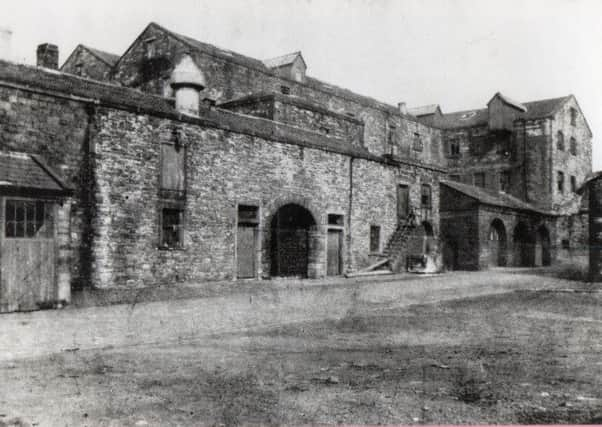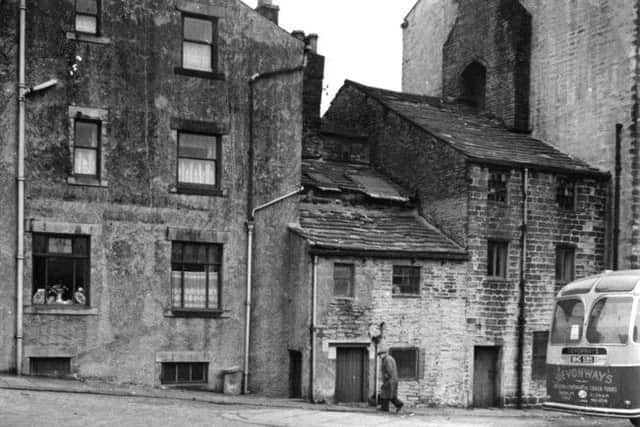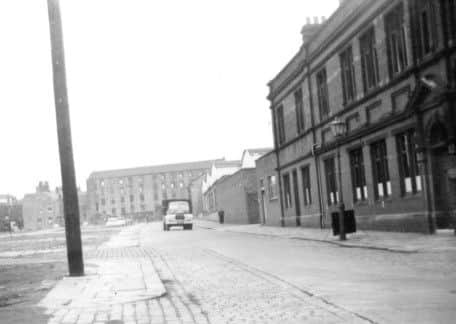Milling history saw Burnley punch above its weight


That mill was Burnley Soke Mill which was situated on the river Brun on what was one of Burnley’s oldest streets, Bridge Street. The building has long since gone but I believe its site can still be identified as being close to the small traffic island at the junction of Kingsway and the remaining length of Bridge Street by the Bridge Bier Huis.
The mill was also known as King’s Corn Mill because, from 1399, it was the property of the Crown. The building was leased to both the Towneleys and Shuttleworths and was sub-let to millers who paid a small rent for the use of the mill. Last week we reached the point where the mill was in the hands of the Shuttleworths who sub-let the mill to a series of millers who operated the mill.
Advertisement
Hide AdAdvertisement
Hide AdThe millers included John Taylor, who died in 1718, his son in law John Halstead and, from about 1780, Mr Halstead’s son in law, William Crook. William’s son, Henry, took the lease in 1805. He, and his father before him, expanded the business considerably, building in c1800 the Old Brewery, next door to the corn mill, and entering the textile industry as the managing partners in the firm of Crook and Tattersall.


From 1814 to 1823 the miller, for Crook and Tattersall, at the King’s Corn Mill, was Matthew Greenwood. He was in charge at the mill when two brothers John and Robinson Greenwood found employment there. It transpires that Matthew was not related to the brothers but their arrival at the mill was to transform the local milling industry.
In 1814 the King’s Corn Mill remained very traditional being driven by water. The brothers were working at the mill when, in 1820, a steam engine was installed. We also know there were also two corn-drying kilns which were used to dry oats at the mill but the mill remained quite small, a situation which did not change substantially until the mill was destroyed by fire in 1852 when Spencer and Moore erected the new King’s Mill on the site.
This latter mill was not intended for corn milling at all. It was a cotton spinning and weaving mill which, in 1879, was leased to the Lancaster Bros, cotton spinners and manufacturers, both there and at Springfield Shed. Older readers will remember this building as home of Nuttalls, the printers, but, from 1852, this site and the building ceases to be part of Burnley’s milling story.
Advertisement
Hide AdAdvertisement
Hide AdHowever, John and Robinson Greenwood had plans for the milling industry in Burnley. They were the sons of James Greenwood (175-1828) who came from Haworth in Yorkshire. It is likely the brothers had worked at the Old Corn Mill (still standing) at Broughton, near Skipton but moved to Burnley in 1806 and found employment, latterly under Matthew Greenwood, at the King’s Mill.


They worked there until 1822 when Robinson, the younger brother, built Basket Street Mill adjacent to the Leeds and Liverpool Canal and near the Culvert. This was Burnley’s second corn mill though we have seen there were corn mills in Padiham, Cliviger, Extwistle, and at Bradley in what is now Nelson.
In 1825 John Greenwood, the older brother, built Pillingfield Mill, the third mill. This property stood in Aqueduct Street which was also next to the canal though further along the Straight Mill and quite close to the Calder Aqueduct which gave the street its name. In some records this mill appears as Aqueduct Mill but it is the same property as Pillingfield Mill.
Thus, in 1825, the firm of John Greenwood was established. It is likely both he and his brother had shops selling meal and flour before they established their mills. John had his shop at 12 Blucher Street, the old name for St James’s Street in the proximity of Hall Street, and Robinson had his shop in the Market Place, the wider part of St James’s Street at the bottom of Manchester Road.
Advertisement
Hide AdAdvertisement
Hide AdIn 1825 there were four corn mills in Burnley, the ancient King’s Corn Mill which, at this time was operated by Spencer and Moore, in Bridge Street; the Basket Street Corn Mill of Robinson Greenwood; the Pillingfield Mill of John Greenwood and a fourth mill, on the Habergham Eaves side of the Calder at Lane Bridge. I suspect this mill was the one in Finsley Gate which was destroyed by fire about 1960 though I have not had the opportunity to trace the history of the building.
In the 1830s and 1840s Burnley’s corn mills remained relatively small serving only the town. Several significant things happened which changed this situation. One was the legal case of 1836 in which the Shuttleworths tried unsuccessfully to protect their ancient rights as the Crown lease holders of the King’s Corn Mill. The decision here meant the other mills in the area were allowed to trade without the fear of legal action from the owners of the socage rights attached to the King’s Mill.
In 1846 the Corn Laws were repealed. From 1815, when the Corn Laws were passed by Parliament, the selling of corn had been regulated but the Act of 1846 opened up the corn market. There was also a considerable fall in the price of corn but there were also opportunities for millers to expand their trade.
Another development was the opening of Burnley’s railway system which, apart from the Great Harwood Loop Line through Padiham, was largely completed in the 1840s. The canal had served Burnley’s corn mills very well but the railways allowed faster access to both ports, like Liverpool, and markets like Manchester, Bradford and Leeds.
Advertisement
Hide AdAdvertisement
Hide AdBy the 1850s John Greenwood and Co were looking to expand their business and, in 1856, they took a lease on Blackburn Old Mill, another ancient Soke Mill. The Blackburn Old Mill had been enlarged in the 1830s with the introduction of steam power in 1836 but, in 1859, Greenwood’s began building the Audley Flour Mill in Walpole Street, Blackburn, which also enjoyed a site on the Leeds and Liverpool Canal. This was a much more modern mill than the premises the firm owned in Burnley.
Back in Burnley, the Basket Street Mill remained in the hands of John Greenwood’s younger brother, Robinson, until his death in 1842. He left the mill to his fourth son, also called Robinson, but the mill was taken over in 1846 by James Smallpage and John Lord and became a cotton spinning mill. After, the building was converted into an iron foundry and, latterly, it was used by Thomas Ashworth’s (TACO) to make cloches for gardeners. It, therefore, ceased to be a corn mill in 1846.
The elder brother’s Burnley interests in corn milling continued to expand. In 1860 John died but was succeeded by three of his sons, the oldest of whom was also called John, who continued to base the firm in Burnley at Pillingfield though the mill, by this time was usually called Aqueduct Mill. The firm also acquired Junction Mill which was located adjacent to Barracks Station. It had been built as a corn mill by John Butterworth in c1860 and was sold to John Greenwood and Sons in 1878. In 1889 Junction Mill was capable of turning out three to four thousand sacks of flour a week.
Just to complete the list of Burnley corn mills, John Butterworth also built the Hill (or Scar) Top Mill, off Church Street, about 1838. This was sold to the Clayton-le-Moors firm of Joseph Appleby and Sons in 1860.
Advertisement
Hide AdAdvertisement
Hide AdJohn Greenwood II died in 1889 and his younger brother James (1844-1917) took over as sole proprietor within a short space of time. In 1891 the firm was incorporated as John Greenwood and Sons Ltd. with its registered office at Aqueduct Mill, Burnley. In 1895 the firm acquired Accrington New Mill (the Borough Corn Mills), which had been built in 1882-3, on the failure of the owner but, in 1912, Greenwood’s opened a new mill at Trafford, Manchester.
In the same year the Aqueduct Mill in Burnley closed for corn milling though the building was still used for distribution. About seven years before, Junction Mill had closed so Greenwood’s had no milling capacity in Burnley from just before the First World War. The mills in Blackburn and Accrington continued but the head office was transferred to Manchester.
The end of the Greenwood connection in Burnley came in 1935 when the last of the Burnley premises at Aqueduct Mill was closed. The year before the firm had gone public but, in 1938, Ranks, which had flour mills all over the country, bought John Greenwood (1934) Ltd. The final act was the demolition of the mill at Pillingfield in 1939.
With the demolition of this mill it could be argued that the Burnley corn milling industry had come to an end. It is, however, worth emphasising that in its milling industry, as with much else, Burnley punched way above its weight. Who would have thought that a town so far away from the corn growing areas of England could have had so many corn mills and that one of the firms founded in Burnley could have become the pre-eminent milling firm in Lancashire?
Of course, this is not the end of the story. Work still needs to be done on the Burnley industry and, if I am able to complete it, I will let you know in this column.